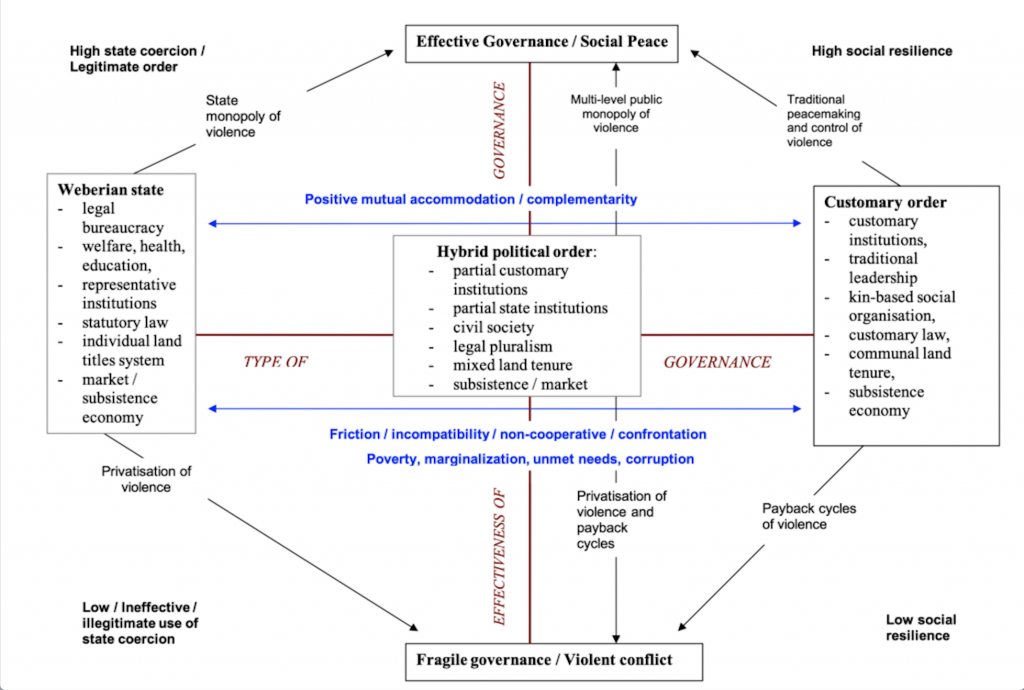8.7: Community Sources of Legitimacy
- Page ID
- 76769
It is important, therefore, that agencies working on enhancing state effectiveness should not just focus on the core functions of the state but also on the fundamental ‘community’ sources of legitimacy as well. State functions are not an end in themselves, but a means to provide citizens with development, internal and external peace and human security. Under conditions of political hybridity these goals may be better served by supporting positive mutual accommodation than by concentrating solely on the institutions of the state. The relationship between state institutions and other sources of social order may be constructive, but it might also be destructive or neutral. The challenge is to find ways of supporting constructive interaction. In order to assess the potential for new types of exchange between state and society it is useful to address three core dimensions of the relationship between the state and the other elements of hybrid political orders, namely:
- Substitution: That is, the identification of functional equivalents of the state outside state institutions. The relation between these functional equivalents and state functions needs more thorough investigation which might lead to the next category, namely,
- Complementarity: The identification of areas of overlap between modern state approaches and customary approaches; this will lead to the investigation of potential for or actual articulation with state institutions; and finally
- Incompatibility: The identification of customary approaches that conflict with modern state approaches.
Assessing core state functions in the light of the three dimensions of substitution, complementarity and incompatibility facilitates a richer and more realistic analysis of the strengths and weaknesses of different states. It underpins a broader understanding of what a functioning and effective state might look like and also helps identify ways to support the emergence of such states.
The development of more fully legitimate state processes grounded in community life will necessitate a sophisticated, ongoing, flexible process of exchange between the local-endogenous and the introduced-exogenous systems. There is no guarantee that this process of exchange will always be successful and it is an open question whether societal and political life in the so-called fragile states can sustain this – not least depending on the political will of the main actors. In any event, what we discovered in work done in Bougainville, the Solomons, Timor Leste, Tonga and Vanuatu, was that societies in the Pacific region have – compared to other regions in the Global South—specific advantages that give reasons for optimism.
To summarize: functioning and effective statehood means that internal and external actors need to focus as much attention on the dimensions of legitimacy and citizenship as they do on strengthening the core functions of the state. It is our contention, based on working in Vanuatu, the Solomons and Timor Leste, that building new forms of state and citizenship that are based on a positive mutual accommodation between the Weberian State and Customary Order will transform hybrid political orders into emerging states that – in the long run – will generate new forms of governance beyond the model western state. Thus in addition to enhancing the state through reinforcing its core functions, a model of governance that is more sensitive to the multi-stranded character of political order in the Pacific will produce more realistic assessments of social and political resilience and the potential for serious violent conflict. In order to develop this new thinking it is important to communicate it through schematic representation of the model, encompassing ideal types and realistic possibilities. The schema represented in Figure 8.1 highlights how political leadership, political responsibility and new concepts of citizenship might be able to generate higher levels of accountability, legitimacy and effectiveness. It does this by focussing attention on ways that generate a more intentional blend between traditional and modern forms of governance – with neither having either a theoretical or practical primacy. By applying the concepts of substitution, complementarity and incompatibility it should be possible to begin mapping where the Weberian state and traditional conventions and institutions have a comparative advantage. Where no obvious advantage can be identified a case can be made for developing hybrid forms that build on the strengths of both systems. In all of this, the aim is to build on the strengths of community, to highlight how kin and other relationships can be made resilient and adaptable and how security might be guaranteed by both traditional and modern institutions. Policy makers need to ensure that the Weberian model possesses a legitimate monopoly of violence and that communities are able to generate high degrees of social resilience. This is best achieved by attending to the positive features of the spheres of state, civil society and customary rule.


